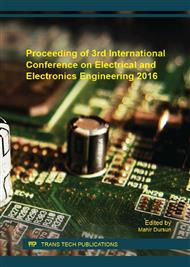[1]
Wang, Ke, et al. Experimental demonstration of high-speed free-space reconfigurable card-to-card optical interconnects., Optics express 21(3), 2850-2861, (2013).
DOI: 10.1364/oe.21.002850
Google Scholar
[2]
Al-Ababneh, Nedal, and Shefa Tawalbeh. Optimizing bandwidth density in free space optical interconnects under the use of error correcting codes., Optical and Quantum Electronics 46(2), 271-282, (2014).
DOI: 10.1007/s11082-013-9758-1
Google Scholar
[3]
Al-Ababneh, Nedal. Crosstalk reduction in free space optical interconnects systems using microlenses with Gaussian transmittance., Optics Communications 318, 79–82, (2014).
DOI: 10.1016/j.optcom.2013.12.063
Google Scholar
[4]
Wenhua Hu, * Xiujian Li, Jiankun Yang, and Di Kong Crosstalk analysis of aligned and misaligned free-space optical interconnect systems, J. Opt. Soc. Am. A 27, 200-205, (2010).
DOI: 10.1364/josaa.27.000200
Google Scholar
[5]
N. S. Petrovic´ and A. D. Rakic´, Modeling diffraction and imaging of laser beams by the mode-expansion method, J. Opt. Soc. Am. B 22, 556–566, (2005).
DOI: 10.1364/josab.22.000556
Google Scholar
[6]
Tang, Suning; Chen, Ray T.; Garrett, Lara; Gerold, Dave; Li, Maggie M. Design limitations of highly parallel free-space optical interconnects based on array of vertical cavity surface-emitting laser diodes, microlenses, and photo detectors, J. Lightwave Technol. 12, 1971-1975, (1994).
DOI: 10.1109/50.336062
Google Scholar
[7]
F. F. Tsai, C. J. O'Brien, N. S. Petrovic´, and A. D. Rakic´, Analysis of optical channel cross talk for free-space optical interconnects in the presence of higher-order transverse modes, Appl. Opt. 44, 6380–6387, (2005).
DOI: 10.1364/ao.44.006380
Google Scholar
[8]
M. Châteauneuf, A. G. Kirk, D. V. Plant, T. Yamamoto, and J. D. Ahearn, 512-channel vertical-cavity surface-emitting laser-based free-space optical link, Appl. Opt. 41, 5552–5561, (2002).
DOI: 10.1364/ao.41.005552
Google Scholar
[9]
R. Wong, A. D. Rakic, and M. L. Majewski, Design of microchannel free-space optical interconnects based on vertical-cavity surface-emitting laser arrays, Appl. Opt., 41( 17), 3469–3478, (2002).
DOI: 10.1364/ao.41.003469
Google Scholar
[10]
Wyant, James C., and Katherine Creath. Basic wavefront aberration theory for optical metrology., Applied optics and optical engineering 11. s 29 (1992).
Google Scholar
[11]
González-Galicia, M. A., et al. Effects of primary spherical aberration, coma, astigmatism, and field curvature on the focusing of ultrashort pulses: Gaussian illumination and experiment., JOSA A 28(10) , 1990-1994, (2011).
DOI: 10.1364/josaa.28.001990
Google Scholar
[12]
Alkelly, Abdu A., H. Al-Nadary, and Ibraheem A. Alhijry. The intensity distribution of hollow Gaussian beams focused by a lens with spherical aberration., Optics Communications 284(1) 322-329, (2011).
DOI: 10.1016/j.optcom.2010.08.040
Google Scholar
[13]
Alkelly, Abdu A. Spot size and radial intensity distribution of focused Gaussian beams in spherical and non-spherical aberration lenses., Optics communications 277(2), 397-405, (2007).
DOI: 10.1016/j.optcom.2007.05.031
Google Scholar
[14]
Baida Lu, Xiangyang Tao, and Yiyou Nie Effect of quartic-phase aberrations on the focal switch of Hermite–Gaussian beams, Optik 116, 454–458, (2005).
DOI: 10.1016/j.ijleo.2005.02.015
Google Scholar
[15]
Xiaoling Ji1, Baida Lu, Focal shift of flattened Gaussian beams passing through a spherically aberrated lens., Optik 113(5), 201–204, (2002).
DOI: 10.1078/0030-4026-00151
Google Scholar
[16]
Rakesh Kumar Singh, P. Senthilkumaran, Kehar Singh, Focusing of a singular beam in the presence of spherical aberration and defocusing., Optik 119, 459–464, (2008).
DOI: 10.1016/j.ijleo.2006.11.012
Google Scholar
[17]
Rakesh Kumar Singh, P. Senthilkumaran, Kehar Singh, Effect of coma on the focusing of an apertured singular beam., Optics and Lasers in Engineering 45, 488–494, (2007).
DOI: 10.1016/j.optlaseng.2006.10.004
Google Scholar
[18]
Y. Cai S. He, Propagation of a Laguerre–Gaussian beam through a slightly misaligned paraxial optical system, Appl. Phys. B 84, 493–500, (2006).
DOI: 10.1007/s00340-006-2321-z
Google Scholar
[19]
S. A. Collins, Lens-systems diffraction integral written in terms of matrix optics, J. Opt. Soc. Am. 60, 1168–1177, (1970).
DOI: 10.1364/josa.60.001168
Google Scholar


